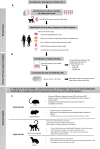Airway models in a pandemic: Suitability of models in modeling SARS-CoV-2
- PMID: 35349597
- PMCID: PMC8963546
- DOI: 10.1371/journal.ppat.1010432
Airway models in a pandemic: Suitability of models in modeling SARS-CoV-2
Conflict of interest statement
The authors have declared that no competing interests exist
Figures


References
Publication types
MeSH terms
Substances
LinkOut - more resources
Full Text Sources
Medical
Miscellaneous

